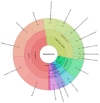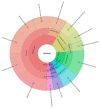Bacteriota and Antibiotic Resistance in Spiders
- PMID: 36005303
- PMCID: PMC9409187
- DOI: 10.3390/insects13080680
Bacteriota and Antibiotic Resistance in Spiders
Abstract
Arthropods are reported to serve as vectors of transmission of pathogenic microorganisms to humans, animals, and the environment. The aims of our study were (i) to identify the external bacteriota of spiders inhabiting a chicken farm and slaughterhouse and (ii) to detect antimicrobial resistance of the isolates. In total, 102 spiders of 14 species were collected from a chicken farm, slaughterhouse, and buildings located in west Slovakia in 2017. Samples were diluted in peptone buffered water, and Tryptone Soya Agar (TSA), Triple Sugar Agar (TSI), Blood Agar (BA), and Anaerobic Agar (AA) were used for inoculation. A total of 28 genera and 56 microbial species were isolated from the samples. The most abundant species were Bacillus pumilus (28 isolates) and B. thuringensis (28 isolates). The least isolated species were Rhodotorula mucilaginosa (one isolate), Kocuria rhizophila (two isolates), Paenibacillus polymyxa (two isolates), and Staphylococcus equorum (two isolates). There were differences in microbial composition between the samples originating from the slaughterhouse, chicken farm, and buildings. The majority of the bacterial isolates resistant to antibiotics were isolated from the chicken farm. The isolation of potentially pathogenic bacteria such as Salmonella, Escherichia, and Salmonella spp., which possess multiple drug resistance, is of public health concern.
Keywords: antibiotic resistance; exogenes microbiota; mass spectrometry; spiders.
Conflict of interest statement
The authors declare no conflict of interest.
Figures



Similar articles
-
Antibiotic-resistant Escherichia coli and Salmonella spp. associated with dairy cattle and farm environment having public health significance.Vet World. 2019 Jul;12(7):984-993. doi: 10.14202/vetworld.2019.984-993. Epub 2019 Jul 8. Vet World. 2019. PMID: 31528022 Free PMC article.
-
Antimicrobial resistance and resistance genes in Salmonella strains isolated from broiler chickens along the slaughtering process in China.Int J Food Microbiol. 2017 Oct 16;259:43-51. doi: 10.1016/j.ijfoodmicro.2017.07.023. Epub 2017 Aug 1. Int J Food Microbiol. 2017. PMID: 28800411
-
[Virulence Genes, Antibiotic Susceptibility Profiles and Molecular Characterization of Campylobacter Species Isolated from Different Slaughterhouses].Mikrobiyol Bul. 2020 Jan;54(1):11-25. doi: 10.5578/mb.68798. Mikrobiyol Bul. 2020. PMID: 32050875 Turkish.
-
In Vitro Antagonistic Effect of Gut Bacteriota Isolated from Indigenous Honey Bees and Essential Oils against Paenibacillus Larvae.Int J Mol Sci. 2020 Sep 14;21(18):6736. doi: 10.3390/ijms21186736. Int J Mol Sci. 2020. PMID: 32937902 Free PMC article.
-
Campylobacter and fluoroquinolones: a bias data set?Environ Microbiol. 2003 Apr;5(4):219-30. doi: 10.1046/j.1462-2920.2003.00425.x. Environ Microbiol. 2003. PMID: 12662169 Review.
Cited by
-
The apple of discord: can spider cocoons be equipped with antimicrobial factors?-a systematic review.Front Zool. 2025 May 28;22(1):9. doi: 10.1186/s12983-025-00563-5. Front Zool. 2025. PMID: 40437581 Free PMC article. Review.
-
Antimicrobial Resistance in Enterococcus spp. Isolates from Red Foxes (Vulpes vulpes) in Latvia.Antibiotics (Basel). 2024 Jan 24;13(2):114. doi: 10.3390/antibiotics13020114. Antibiotics (Basel). 2024. PMID: 38391500 Free PMC article.
References
-
- Koide R. Functional complementarity in the arbuscular mycorrhizal symbiosis. New Phytol. 2000;147:233–235. doi: 10.1046/j.1469-8137.2000.00710.x. - DOI
-
- Peirano A. In vivo measurements of the seasonal photosynthetic fluorescence of the Mediterranean coral Cladocora caespitosa (L.) Sci. Mar. 2007;71:629–635. doi: 10.3989/scimar.2007.71n4629. - DOI
Grants and funding
- 010SPU-4/2021./This research was funded by KEGA, grant number
- 313011W112,/This publication was supported by the Operational program Integrated Infrastructure within the project: Sustainable smart farming systems taking into account the future challenges co-financed by the European Regional Development Fund.
LinkOut - more resources
Full Text Sources
Research Materials
Miscellaneous

